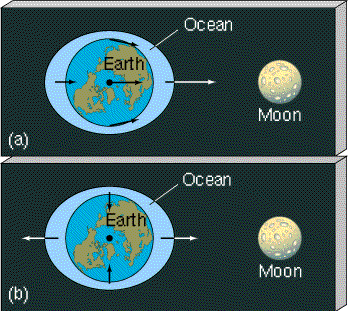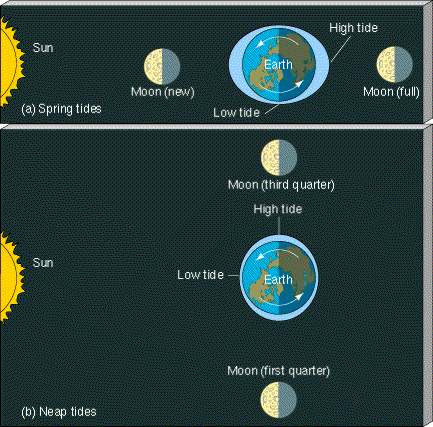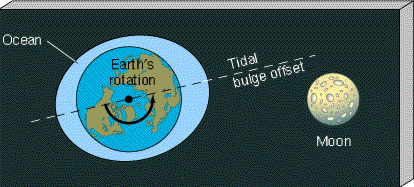Earth is unique among the planets in that it has large quantities of liquid water on its surface. Approximately three quarters of Earth's surface is covered by water, to an average depth of about 3.6 km. Only 2 percent of the water is contained within lakes, rivers, clouds, and glaciers. The remaining 98 percent is in the oceans.
A familiar hydrospheric phenomenon is the daily fluctuation in ocean level known as the tides. At most coastal locations on Earth, there are two low tides and two high tides each day. The "height" of the tides—the magnitude of the variation in sea level—can range from a few centimeters to many meters, depending on the location on Earth and time of year. The height of a typical tide on the open ocean is about a meter, but if this tide is funneled into a narrow opening such as the mouth of a river, it can become much higher. For example, at the Bay of Fundy, on the Maine—Canada border, the high tide can reach nearly 20 m (approximately 60 feet, or the height of a six-story building) above the low-tide level. An enormous amount of energy is contained in the daily motion of the oceans. This energy is constantly eroding and reshaping our planet's coastlines. In some locations, it has been harnessed as a source of electrical power for human activities.
What causes the tides? A clue comes from the observation that they exhibit daily, monthly, and yearly cycles. In fact, the tides are a direct result of the gravitational influence of the Moon and the Sun on Earth. We have already seen how gravity keeps Earth and Moon in orbit about each other, and both in orbit around the Sun.
(Sec. 2.7) For simplicity, let us first consider just the interaction between Earth and the Moon.
Recall that the strength of the gravitational force depends on the distance separating any two objects. Thus, the Moon's gravitational attraction is greater on the side of Earth that faces the Moon than on the opposite side, some 12,800 km (Earth's diameter) farther away. This difference in the gravitational force is small—only about 3 percent—but it produces a noticeable effect—a tidal bulge. As illustrated in Figure 7.22, Earth becomes slightly elongated, with the long axis of the distortion pointing toward the Moon.

Figure 7.22 This exaggerated illustration shows how the Moon induces tides on both the near and the far sides of Earth. The lengths of the straight arrows indicate the relative strengths of the Moon's gravitational pull on various parts of Earth. (a) The lunar gravitational forces acting on several different locations on and in Earth. The force is greatest on the side nearest the Moon and smallest on the opposite side. (b) The difference between the lunar forces experienced at those same locations and the force acting on Earth's center. The arrows represent the force with which the Moon tends to pull matter away from, or squeeze it toward, the center of our planet. Material on the side of Earth nearest the Moon tends to be pulled away from the center, and material on the far side is "left behind," and a bulge is formed. High and low tides result, twice per day, as Earth rotates beneath the bulges in the oceans.
Earth's oceans undergo the greatest deformation because liquid can most easily move around on our planet's surface. (A bulge is actually raised in the solid material of Earth, but it is about a hundred times smaller than the oceanic bulge.) Thus, the ocean becomes a little deeper in some places (along the line joining Earth to the Moon) and shallower in others (perpendicular to this line). The daily tides we experience result as Earth rotates beneath this deformation.
Notice in Figure 7.22 that the side of Earth opposite the Moon also experiences a tidal bulge. The different gravitational pulls—greatest on that part of Earth closest to the Moon, weaker at Earth's center, and weakest of all on Earth's opposite side—cause average tides on opposite sides of our planet to be approximately equal in height. On the side nearer the Moon, the ocean water is pulled slightly toward the Moon. On the opposite side, the ocean water is left behind as Earth is pulled closer to the Moon. Thus, high tide occurs twice, not once, each day at any given location.
Both the Moon and the Sun exert tidal forces on our planet. Even though the Sun is roughly 375 times farther away from Earth than is the Moon, its mass is so much greater (by a factor of about 27 million) that its tidal influence is still significant—about half that of the Moon. Thus, instead of one tidal bulge, there are actually two—one pointing toward the Moon, the other toward the Sun—and the interaction between them accounts for the changes in the height of the tides over the course of a month or a year. When Earth, the Moon, and the Sun are roughly lined up (Figure 7.23a), the gravitational effects reinforce one another, and so the highest tides are generally found at times of new and full moons. These tides are known as spring tides. When the Earth—Moon line is perpendicular to the Earth—Sun line (at the first and third quarters; Figure 7.23b), the daily tides are smallest. These are termed neap tides.

Figure 7.23 The combined effects of the Sun and the Moon produce variations in the high and low tides. (a) When the Moon is either full or new, Earth, Moon, and Sun are approximately aligned, and the tidal bulges raised in Earth's oceans by the Moon and the Sun reinforce one another. (b) At first or third-quarter Moon, the tidal effects of the Moon and the Sun partially cancel, and the tides are smallest. The Moon's tidal effect is greater than that of the Sun, and so the net bulge points toward the Moon.

Figure 7.24 The tidal bulge raised in Earth by the Moon does not point directly at the Moon. Instead, because of the effects of friction, the bulge points slightly "ahead" of the Moon, in the direction of Earth's rotation. (The magnitude of the effect is greatly exaggerated in this diagram.) Because the Moon's gravitational pull on the near-side part of the bulge is greater than the pull on the far side, the overall effect is to decrease Earth's rotation rate.
The variation of the Moon's gravity across Earth is an example of a differential force, or tidal force. The average gravitational interaction between two bodies determines their orbit around each other. However, the tidal force, superimposed on that average, tends to deform the bodies themselves. The tidal influence of one body another diminishes very rapidly with increasing distance—in fact, as the inverse cube of the separation. For example, if the distance from Earth to the Moon were to double, the tides resulting from the Moon's gravity would decrease by a factor of 8. We will see many situations in this book where tidal forces are critically important in understanding astronomical phenomena. Notice that we still use the word tidal in these other contexts, even though we are not discussing oceanic tides and possibly not even planets at all.
According to the Earth Data box, Earth rotates once on its axis (relative to the stars) in 23h 56m—1 sidereal day. However, we know from fossil measurements that Earth's rotation is gradually slowing down, causing the length of the day to increase by about 1.5 milliseconds (ms) every century—not much on the scale of a human lifetime, but over millions of years, this steady slowing of Earth's spin adds up. At this rate, half a billion years ago, the day was just over 22 hours long and the year contained 397 days.
A number of natural biological clocks lead us to the conclusion that Earth's spin rate is decreasing. For example, each day a growth mark is deposited on a certain type of coral in the reefs off the Bahamas. These growth marks are similar to the annual rings found in tree trunks, except that in the case of coral, the marks are made daily, in response to the day—night cycle of solar illumination. However, they also show yearly variations as the coral's growth responds to Earth's seasonal changes, allowing us to perceive annual cycles. Coral growing today shows 365 marks per year, but ancient coral shows many more growth deposits per year. Fossilized reefs that are five hundred million years old contain coral with nearly 400 deposits per year of growth.
Why is Earth's spin slowing? The main reason is the tidal effect of the Moon. In reality, the tidal bulge raised in Earth by the Moon does not point directly at the Moon, as was shown in Figure 7.22. Instead, because of the effects of friction, both between the crust and the oceans and within Earth itself, Earth's rotation tends to drag the tidal bulge around with it, causing the bulge to be displaced by a small angle from the Earth—Moon line, in the same direction as Earth's spin (Figure 7.24). The net effect of the Moon's gravitational pull on this slightly offset bulge is to reduce our planet's rotation rate. At the same time, the Moon is spiraling slowly away from Earth, increasing its average distance from our planet by about 4 cm per year.
This process will continue until Earth rotates on its axis at exactly the same rate as the Moon orbits Earth. At that time the Moon will always be above the same point on Earth and will no longer lag behind the bulge it raises. Earth's rotation period will be 47 of our present days, and the distance to the Moon will be 550,000 km (about 43 percent greater than at present). However, this will take a very long time—many billions of years—to occur.